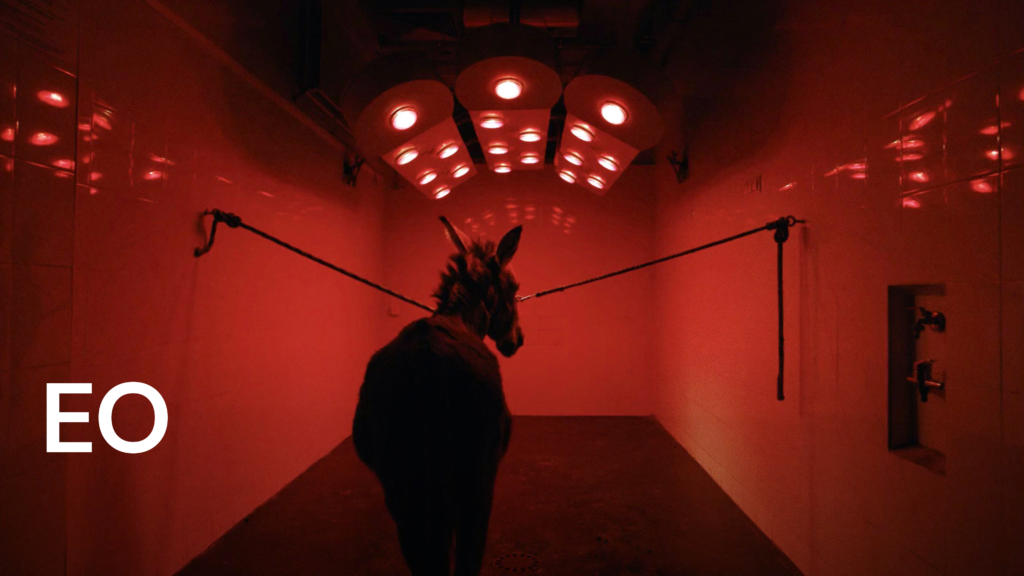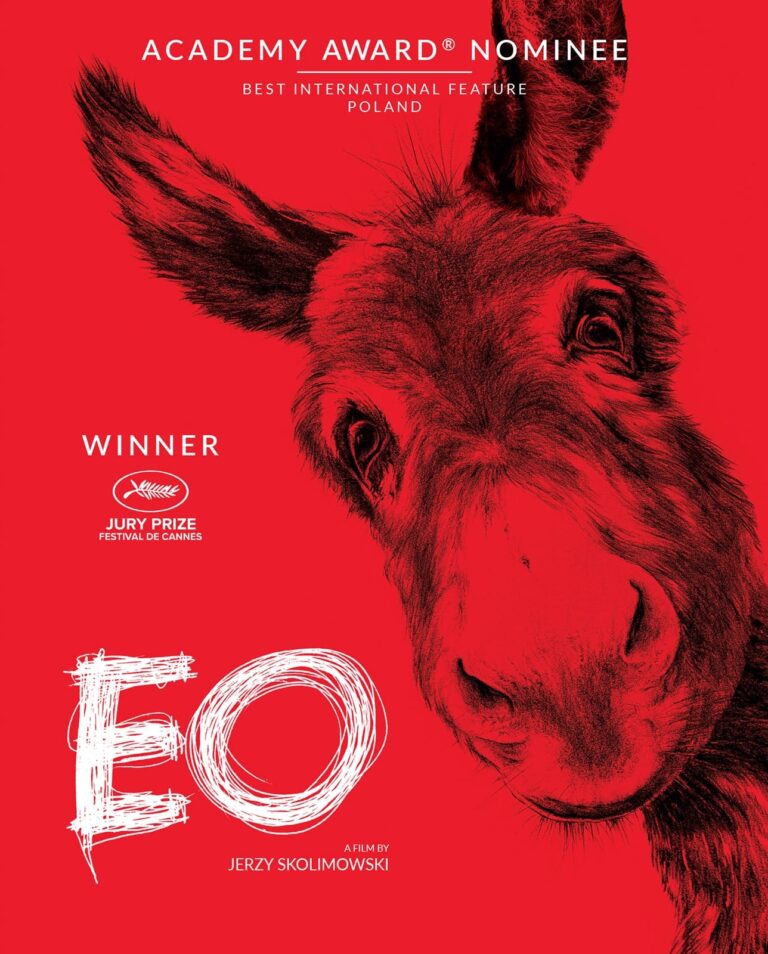EO – Snapshot
EO is one of those rare movies where, not knowing exactly how, the film transports you into a different kind of world. In the end you never knew that you would have so much empathy for a donkey while exploring the meaning of consciousness. (4.5*)
Where to Watch:
Stream: ???
Rent: Prime/Apple ($4); Vudu ($6)
(Note: this movie is not at all appropriate for kids!)
EO – The Oscar Buzz
Oscar Nominations:
International Feature Film (Poland)
EO received a single nomination for International Feature Film, putting it in our “special interest” list. (All Quiet on the Western Front from Germany won the Oscar).
EO – The Movie’s Family Tree
The Following Movies Share Talent with This One (and if you like these films, you might like this one):
11 Minutes (15): Director/Co-Writer (Skolimowki); Co-Writer (Piaskowska ); Composer (Mykietyn); Editor (Glinska); Sound (Ochnio)
Essential Killing (10): Director/Co-Writer (Skolimowki); Co-Writer (Piaskowska ); Composer (Mykietyn)
Four Nights with Anna (08) / Organek: Czarna Madonna (17): Director/Co-Writer (Skolimowki); Co-Writer (Piaskowska )
Jerzy Skolimowski is the Polish filmmaker behind EO. Although I’ve seen a few Polish films in my lifetime, I reviewed Skolimowki’s list of works and I am not immediately familiar with any of them. Nonetheless, since he was born in 1938, he has been writing, directing, and acting in films since 1960. Like most filmmakers, he has assembled a team for this one that he knows and who, naturally, understand his sensibilities. The three films listed above seem to share the most talent with the team for EO.
Acting, though, is not listed in these references. And, besides not finding much overlap, there is a reason for that – the human performances, aside from maybe one, are simply not all that relevant, except as counterpoints. The story is, ostensibly about a donkey and the story is told with EO, the donkey, as the focal point. Even a brief appearance by French actress Isabelle Huppert, although somewhat intriguing, is not part of the center thread of the film.
EO – What Others Think
EO is only available to rent on a few streaming services and is not available to stream free, as part of a subscription, anywhere that I could find. That means that the number of people who have seen it is actually quite small (and that is unfortunate). Among the small number of viewers who have rated the film, it comes in at the bottom of this year’s five International features and is in the bottom third of all 39 films in this year’s Oscar list.
Critics, on the other hand, liked this movie ranking it second only behind The Quiet Girl (of International Features), and placing it in the top third of all this year’s films. Manohla Dhargis (New York Times) gave the film a Critics Pick and raved “No movie that I’ve seen this year has moved me as deeply, made me feel as optimistic about cinema or engaged me with such intellectual vigor as EO.” She argues the director “is inviting us to make the empathetic leap across species and consciousness, to look at the world we’ve made for ourselves and to see, really see, what we lose by treating other beings as lesser.” Christina Newland (Sight&Sound) suggested “the film can be unwieldy, cartoonish and head-scratching. And yet it is bold in a way few contemporary films truly are, and its culmination of sound and image before the Final Cut to black is like a fist closing around your heart.”
Not everyone raved about EO. Robert Daniels (RogerEbert) suggested that “it’s too engaged with being feckless shock treatment to thoughtfully reflect the viewer’s own actions back at them.” And Ben Kenigsberg (also RogerEbert) said that Skolimowski seems to not care “that he’s appropriating one of the most famous and strange conceits in film history.” (The 1966 film from Robert Bresson, Au hasard Balthazar. Why a remake of a sixty-six year old film is a problem is beyond me, but I guess Kenigsberg had to write something to support his negative opinion.)
EO – Special Mention
Animal Consciousness – This is probably the biggest concept underlying this film. And over the last couple of days I started to dig a bit into this subject. What I discovered very quickly dissuaded me from going down this rabbit-hole too deeply – but I like provocative ideas, so I’ll stick one leg in the rabbit hole… The problem, ultimately, is that it is next to impossible to talk about whether animals are conscious when we really don’t even know how humans are conscious. Fundamentally, we don’t know what “consciousness” is.
You could start with a simple notion of sentience – that an organism experiences reactions to events in its environment. And a critical threshold is reached if an organism experiences “pain”. We are pretty sure that most, if not all animals, experience something like pain. But there is also evidence that when a plant stem is cut, that there is a reaction, at least locally, that is visceral, immediate, and registers with the plant. Does that not describe “pain”? So maybe plants are also sentient!?
So we need to add a layer of interpretation. Maybe we need an “emotional” response in order to make sure there is some kind of feeling. Well, in humans, it turns out that emotions tend to be expressed and/or caused as different combinations of at least three different neurotransmitters – serotonin, dopamine, and noradrenaline. But other animals have these same chemicals in their brains and there is no reason they do not react similarly to humans. So is it fair to say that, at least some animals, have emotions and feelings? I know that, after leaving our two corgis by themselves for a day we get quite the dressing down. Is it really the case that we are projecting our own expectations on to them (i.e. anthropomorphizing), or are they actually expressing emotions of maybe anger (that we left) and relief (that we returned)??
Some researchers have defined consciousness, or at least some part of it, as the recognition of the “self” and have operationalized it as the ability to see oneself in a mirror. Turns out that many animals have demonstrated that capability ranging from elephants to monkeys and even a bird or two. So, clearly, that doesn’t make a defining difference.
Definitely memory has a key role in the whole thing. Self-recognition, for example, requires having some kind of memory of past experiences of seeing oneself (in a mirror, for example). But my dogs have memories when we return after being away for a night. If they didn’t, how would they know we have come home and aren’t some stranger? Memory, and how much of it an organism has, likely plays a big part in determining conscious thought.
Then there is the big and obvious difference of language – humans have developed a remarkable ability to symbolize thoughts and assemble them in sentences and stories – language is one of the huge differences between animals and humans. But even that is breaking down a bit as we come to understand that there are primitive levels of symbolism in the communications of other animals. The combination of larynx, tongue, and lips that we humans have developed seems to offer many more sound combinations than other animals can practice, but there is evidence that other species also ‘speak’ to each other – just in radically different languages (consider whales for example!).
But does language and “consciousness” go hand in hand – must you have both of them at the same time in order to have either? Or is it possible that language just allows the more fluid communication of consciousness between individuals. Maybe consciousness is there, simmering and stewing just waiting to burst forth in surprising ways. I don’t think we really know how all that works well enough to cast final judgments. EO is asking the viewer to consider such things.
EO – Michael’s Moments
EO is, on the surface, about a donkey and his life. We follow him from one “job” to another, getting into more and more trouble, just because he has the persistence to not die! He never speaks – this isn’t a Disney film – and we aren’t even given dialog that he might be thinking. Instead Director Jerzy Skolimowski and his cinematographer Michel Dymek give us time to peer deeply into his eyes as he scans the world outside of his pen. Or we watch his big ears twist and turn as he listens to his difficult world. We are asked to see the world as EO sees and hears it, not as humans experience it. It is, in many ways, simpler and in others much more difficult. He has less control over what happens to him than most humans and, when he does do things humans don’t like, he suffers. But there is no suggestion that EO’s experience of moral consciousness is any less important than that of his human handlers.
But that’s not the full extent of what this seasoned filmmaker is trying to communicate. He is also saying something about the nature of consciousness itself and of how humans don’t really have a monopoly on either consciousness, nor of our understanding of what it might be. There is a very curious two minutes around the 48 minute mark involving a robot dog. The robot and EO never meet – the robot sequence is entirely an aside. But in that sequence we see the bot explore its surroundings (curiosity?), hesitate before proceeding in some instances (thinking?), reacting to his own self image in a pool of water (recognition of self?), toppling over onto its back after encountering an obstacle, righting itself, and proceeding (recovery from a setback and determination?). Although the entire sequence has nothing to do from a plot perspective with the rest of the film, it has everything to do with the primary focus of the movie – consciousness!
EO also used multiple visual techniques to challenge the viewer – it probably needs to be considered something of an art-house film. Skolimowski and Dymek repeatedly use primary color filters (blue, yellow, and especially red) to tell parts of the story and communicate potential feelings EO might be having. (I don’t think I figured out exactly how each of them relate to specific emotional feelings, but red is definitely associated with passion of different kinds, blue seems to reflect coldness and sadness, and yellow may be times of uncertainty.) These emotional queues are also enhanced by the musical score. They also make extensive use of drones in often beautiful ways.
EO is the kind of movie where you simply sit there, somewhat stunned for its duration trying to figure out how it is having such an impact on you. The filmmakers successfully take you inside EO’s soul in ways you don’t anticipate. The techniques are both subtle and outrageous. I suspect most people will either love this film for the depth of feeling, or hate it for making you feel that way. I, for one, loved it. (4.5*)


